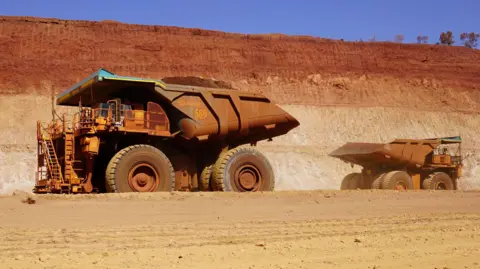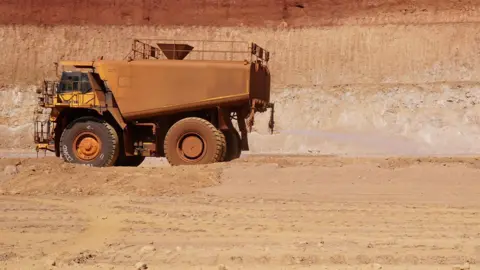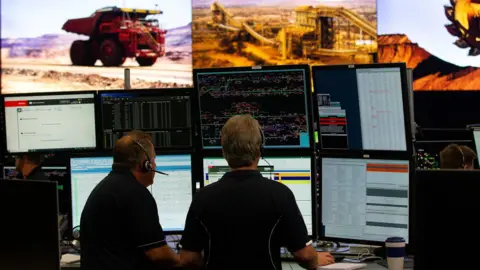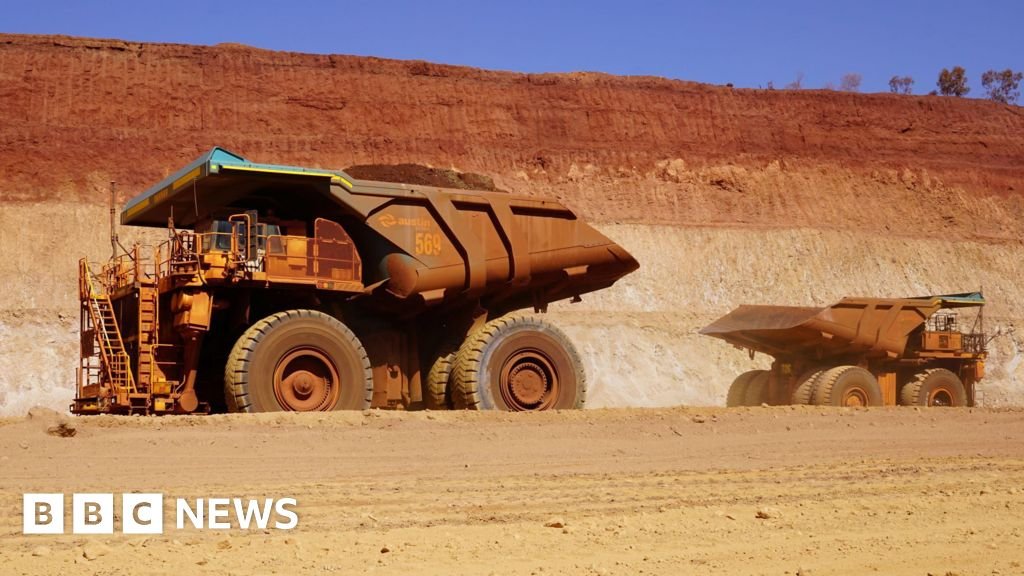 Zoe Corbyn
Zoe CorbynIt does not get rather more distant than this. I am in inland Western Australia, at Rio Tinto’s Better Nammuldi iron ore mine.
It is a couple of two-hour flight north from Perth in a area referred to as the Pilbara.
No-one lives completely right here. Round 400 staff are on the location at anybody time, and they’re flown in, working between 4 and eight days, relying on their shift sample, earlier than flying dwelling.
Large vans the scale of townhouses, able to hauling 300 tonnes, criss-cross red-earth roads in numerous sections of this open-pit mine advanced.
For an outsider like me their measurement is intimidating sufficient, however multiplying that feeling is the data that there is not any driver on the wheel.
Throughout a tour of the location in a normal-sized firm car, one of many vans comes into view, approaching from a aspect street.
I sigh with aid because it deftly turns and continues within the course we’ve simply come. “Did it make you are feeling uncomfortable?,” asks the car’s driver Dwane Pallentine, a manufacturing superintendent.
 Zoe Corbyn
Zoe CorbynBetter Nammuldi has a fleet of greater than 50 self-driving vans that function independently on pre-defined programs, together with a handful that stay manually pushed and work individually in a unique a part of the mine.
Being trialled can be an autonomous water cart affectionately generally known as Henry, which, together with manually pushed ones, sprays the mine roads to maintain the mud down.
The corporate car I’m in is ready to function alongside the autonomous vans solely as a result of it has been fitted with high-accuracy GPS, which permits it to be seen inside a digital system.
Earlier than getting into the mine’s gated autonomous zone, we logged onto this method and a controller verified over the radio that we had been seen.
It has encased our car in a digital bubble that the self-driving vans “see” and which causes them to handle their proximity by slowing or stopping as obligatory.
A contact display screen in our cabin shows all of the staffed and autonomous autos and different tools within the neighborhood, together with “permission traces” that present the instant routes the self-driving vans are aspiring to take. Had I regarded on the display screen as an alternative of fretting I might have seen that truck was going to show.
Along with all autos being fitted with a giant pink emergency button that may cease the system, the autonomous vans have lasers and radars entrance and rear to detect collision dangers.
The sensors additionally detect obstacles. If a big rock fell off the again of a truck, the sensors on the following truck alongside would discover it and the car would cease.
Nevertheless, some vans appear further delicate – on my tour I see a pair foiled just by tough roads.
Co-ordinating and monitoring these robots is Rio Tinto’s Operations Centre (OC) in Perth, about 1,500km (930 miles) to the south.
It’s the nerve centre for all the corporate’s Pilbara iron ore operations, which span 17 mines in complete, together with the three making up Better Nammuldi.
Guided from right here by controllers, embody greater than 360 self-driving vans throughout all of the websites (about 84% of the entire fleet is automated); a principally autonomous long-distance rail community to move the mined ore to port services; and practically 40 autonomous drills. OC employees additionally remotely management plant and port capabilities.
Autonomy isn’t new to Rio’s Pilbara operations: introduction started within the late 2000s.
Neither is it distinctive: Australia has the best variety of autonomous vans and mines that use automation of any nation, and different mining firms within the Pilbara additionally use the know-how.
However the scale Rio has grown its operations to right here, together with at Better Nammuldi – which has one of many largest autonomous truck fleets on the planet – provides it world significance.
And it is a world development. According to GlobalData the variety of self-driving haul vans worldwide has roughly quadrupled over the previous 4 years to greater than 2,000, with most made by both Caterpillar or Komatsu.
 Rio Tinto
Rio TintoThe largest motive for introducing the know-how has been to enhance the bodily security of the workforce, says Matthew Holcz, the managing director of the corporate’s Pilbara mines.
Mining is a harmful occupation: heavy equipment will be unpredictably operated by individuals who may develop into fatigued. “The information clearly reveals that, by means of automation, we have got a considerably safer enterprise,” says Mr Holcz.
It has additionally improved productiveness – to the tune of about 15%, he estimates. Autonomous tools can be utilized extra as a result of there aren’t any gaps resulting from shift modifications or breaks. And autonomous vans may go sooner when there may be much less staff-operated tools on the scene.
Such automation doesn’t come low-cost. Rio gained’t disclose what it has spent in complete on its Pilbara automation journey thus far, however observers put it at a number of billions of {dollars}.
In the meantime, employment alternatives have advanced. The narrative could be considered one of robots taking jobs, however that doesn’t appear the case right here to this point.
Whereas the OC has about one controller for each 25 autonomous vans – in response to Rio, nobody has misplaced their job due to automation.
As an alternative, there have been redeployments: truck drivers have joined the OC as controllers themselves, been reskilled to function completely different items of kit, similar to excavators, loaders and dozers, or gone to drive handbook vans at completely different websites.
On the OC’s massive open plan ground, amid the banks of displays organized in clusters for the completely different mines, I meet Jess Cowie who used be a handbook driller however now directs autonomous ones from the central drill pod. “I nonetheless put holes within the floor…simply with out the mud, the noise and being away from the household,” she says.
 Zoe Corbyn
Zoe CorbynAutomation is delivering a “step change” when it comes to security within the mining trade says Robin Burgess-Limerick, a professor on the College of Queensland in Brisbane who research human elements in mining. However it doesn’t imply there isn’t room for enchancment.
Professor Burgess-Limerick has analysed incidents involving autonomous tools reported to regulators.
As he sees it, the interfaces utilized by employees each within the discipline and in management centres to realize data aren’t optimally designed. There have been conditions the place discipline employees have misplaced consciousness of the scenario, which higher display screen design could have prevented. “The designers of the know-how ought to put a bit extra effort into contemplating folks,” he says.
And there may be additionally a danger that controllers’ workloads will be overwhelming – it’s a busy, excessive stakes job.
Over-trust, the place folks develop into so assured the autonomous tools will cease that they begin placing themselves in danger, can be a problem, and he notes effort must be directed into bettering the power of vans themselves to detect moisture. There have been incidents the place moist roadways have brought on them to lose traction.
There will be reliable security issues with autonomous tools, says Shane Roulstone, co-ordinator for the Western Mine Employees Alliance, which represents mining-related staff within the Pilbara.
He factors to a severe incident this Might the place an autonomous prepare slammed into the again of a broken-down prepare, which staff on the entrance finish had been repairing (they evacuated earlier than it hit however had been left shaken).
However Mr Roulstone additionally praises Rio usually for having, over time, developed “some good methods, procedures and insurance policies” round how folks work together with automated autos.
Mr Roulstone expects that in some unspecified time in the future choices for redeployment will reduce and there’ll job losses. “It’s simply the arithmetic of it,” he says.
In the meantime, Rio’s automation journey within the Pilbara continues with extra vans, drills and Henry the water cart. It’s also carefully watching work by Komatsu and Caterpillar to develop un-staffed excavators, loaders and dozers.
Late within the afternoon, ready at Better Nammuldi’s airport for the final flight again to Perth, the announcement comes that it has been cancelled resulting from a problem with the aircraft. That’s 150 further individuals who will now must be fed and accommodated. It’s nothing for Rio, however I can’t assist however suppose we people are difficult in comparison with robots.


